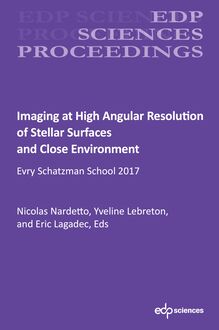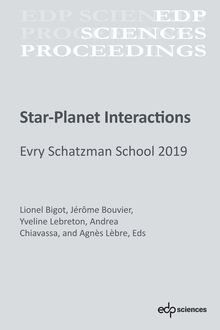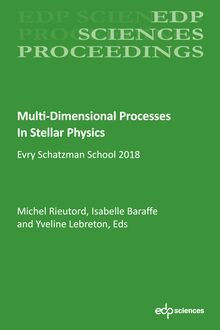-
 Univers
Univers
-
 Ebooks
Ebooks
-
 Livres audio
Livres audio
-
 Presse
Presse
-
 Podcasts
Podcasts
-
 BD
BD
-
 Documents
Documents
-
- Cours
- Révisions
- Ressources pédagogiques
- Sciences de l’éducation
- Manuels scolaires
- Langues
- Travaux de classe
- Annales de BEP
- Etudes supérieures
- Maternelle et primaire
- Fiches de lecture
- Orientation scolaire
- Méthodologie
- Corrigés de devoir
- Annales d’examens et concours
- Annales du bac
- Annales du brevet
- Rapports de stage
La lecture à portée de main
Découvre YouScribe en t'inscrivant gratuitement
Je m'inscrisVariability of the Sun and Sun-like Stars: from Asteroseismology to Space Weather , livre ebook
Découvre YouScribe en t'inscrivant gratuitement
Je m'inscrisEn savoir plus
En savoir plus

Description
This book is based on contributions presented at the first International Conference on Solar Physics which was organized in Baku, Azerbaijan in July 06–08, 2015, by the Science Development Foundation under the President of the Republic of Azerbaijan.
The primary goals were to highlight specific aspects of modern solar physics research, including observation and theory that span from the interior of the Sun out into the wider heliosphere, as well as solar-terrestrial physics and particularly, sun-like stars.
The Sun is a variable star. However, we are still far from fully understanding what and how causes this variability. Why does the Sun continue to go on, on a rhythmic scale, the so-called solar cycle, without damping? How to better understand the complicated relationships between the Sun, the heliosphere and the many proxies of long-term solar activity? How the data could be fully exploited for a better understanding of solar changes on the longest possible time scales? How our knowledge on the Sun can be transfer to other stars? What are the impacts on our terrestrial environment?
These questions shape the architecture of the book. It will be of interest and useful to scientists and graduate level readers who would like to better master such up-to-date topics.
Sujets
Informations
| Publié par | EDP Sciences |
| Date de parution | 17 avril 2018 |
| Nombre de lectures | 0 |
| EAN13 | 9782759821969 |
| Langue | English |
| Poids de l'ouvrage | 24 Mo |
Informations légales : prix de location à la page 0,6000€. Cette information est donnée uniquement à titre indicatif conformément à la législation en vigueur.
Extrait
Variability of the Sun
and Sun-like Stars:
from Asteroseismology
to Space Weather
J.-P. Rozelot and E.S. Babayev, EdsPrinted in France
ISBN(print): 978-2-7598-2195-2 – ISBN(ebook): 978-2-7598-2196-9
All rights relative to translation, adaptation and reproduction by any means whatsoever
are reserved, worldwide. In accordance with the terms of paragraphs 2 and 3 of Article
41 of the French Act dated March 11, 1957, “copies or reproductions reserved strictly
for private use and not intended for collective use” and, on the other hand, analyses
and short quotations for example or illustrative purposes, are allowed. Otherwise, “any
representation or reproduction – whether in full or in part – without the consent of the
author or of his successors or assigns, is unlawful” (Article 40, paragraph 1). Any
representation or reproduction, by any means whatsoever, will therefore be deemed an
infringement of copyright punishable under Articles 425 and following of the French
Penal Code.
© EDP Sciences, 2018 Preface
The topical issue of “Variability of the Sun and Sun-Like Stars: From
Asteroseismology to Space Weather” is based on contributions presented at the first
International Conference on Solar Physics which was organized in Baku,
Azerbaijan in July 06–08, 2015.
The primary goals were to highlight all aspects of modern solar physics
research, including observation and theory that span from the interior of the
Sun out into the wider heliosphere, as well as solar-terrestrial physics and
particularly, sun-like stars.
Around 120 people were gathered in Baku (both from domestic and abroad)
to share the findings of their research in solar and solar-terrestrial physics.
All international scientists appreciated to live a while in this beautiful capital
and largest city of Azerbaijan, housing many scientific and cultural
headquarters, including the Science Development Foundation under the President of the
Republic of Azerbaijan. This foundation hosted and financed the Conference, for
which one of the sessions has been held at the Shamakhy Astrophysical
Observatory of the Azerbaijan National Academy of Sciences, a delightful place in the
Caucasian mountains.
This book does not cover all issues addressed in the Conference but tackled
some of them to pinpoint the best of international research in the field of the
Solar Variability and Space Weather.
It is clear today that the Sun is a variable star. However, we are still far from
fully understanding what and how causes this variability. Why does the Sun
continue to go on, on a rhythmic scale, the so-called solar cycle, without damping?
How to better understand the complicated relationships between the Sun, the
heliosphere and the many proxies of long-term solar activity? How the data could
be fully exploited for a better understanding of solar changes on the longest
possible time scales? How our knowledge on the Sun can be transfer red to other stars?
These questions shape the architecture of the book.
• The first seven chapters in Section 1 “Solar Physics” focus on the
Physics of the Sun. In the recent years helioseismology provided us with
important information about the interior of the Sun. After recalling
briefly the principles of helioseismology, Chapter 1 by S. Ehgamberdiev
describes the scientific results obtained at the Ulugh Beg Astronomical
Institute (UBAI) in the framework of an International Research on the
Interior of the Sun. In a comprehensive review, A. Kosovichev et al.
study in Chapter 2 the development of local helioseismology which
provides a unique opportunity to investigate the subsurface structure and
dynamics of active regions and their effect on the largescale flows and
global circulation of the Sun. The two next Chapters (3 and 4) by Alan
00_Preface_TOC.indd 1 03/01/2018 9:15:55 AMII Preface
A. Wray et al. and I. Kitashvili focus on realistic numerical simulations,
i.e., those that make minimal use of ad hoc modeling, which are
essential for understanding the complex turbulent dynamics of the interiors
and atmospheres of the Sun (and other stars) and the basic mechanisms
of their magnetic activity and variability.
Chapter 5 is a general up-to date history of the measurements of the
solar diameter viewed from a critical quality assessment of the existing
data. From an astrophysical point of view, this topic is closely link with
the study of the solar Near Sub-Surface Layer (NSSL or “leptocline”)
and therefore directly understood through mechanisms explained in
Chapter 2.
In the scope of the study of the solar cyclicity characteristics, V.N.
Ishkov develops in Chapter 6 statistics leading to different scenarios
of the regular changes of magnetic field in the solar convection zone
generation regime, in accordance with the epoch of low or high activity.
Lastly, Chapter 7 in this Section, by N.S. Dzhalilov, focuses on the
wave instabilities in an anisotropic magnetized space plasma whose
results are of importance for the description of wave processes in the
solar corona and solar wind. Thus, this Chapter constitutes a good
transition with Section (3) dedicated to space weather.
• The next Section 2 is devoted to “recent developments from
helioseismology to asteroseismology” and are presented by J.
ChristensenDalsgaard. Transposing the results obtained from helioseismology to
asteroseismology has already been very profitable. In the last decade
extensive observations of stellar oscillations, in particular from space
photometry, have provided very detailed information about the global
and internal properties of stars. As explained in this Chapter 8,
remarkable insight has been obtained on the properties of evolved stars, and
many new results are expected in the near future.
• Section 3 is dedicated to peculiar aspects of “Space Weather”. This
concept was launched some 15 years ago to describe the short-term
variations in the different forms of solar activity, and their effects in the
near-Earth environment and technoculture. The ultimate goal is to get
a better understanding of the full chain of effects from the Sun to the
Earth. Here the focus is put on the influence of cosmic rays.
In Chapter 9 by L. Dorman and E.S.Babayev, the authors deal with
the issue of whether there is an appropriate role of Cosmic Rays on
Satellites Operation, Technologies, Biosphere and People Health.
By contrast, L. Dorman et al. focus in Chapter 10 on how to forecast
exactly dangerous phenomena from space on the Earth’s civilization
and propose steps for founding a cosmic ray warning system.
Chapter 11 is dedicated to Space Weather effects on human health.
S. Dimitrova and E.S.Babayev reviews here collaborative
investigations performed at middle Earth latitudes and at different geographical
00_Preface_TOC.indd 2 03/01/2018 9:15:55 AM Preface III
places in order to study the potential effects of space weather on human
physiological and psycho-physiological state and acute cardio-vascular
incidences.
• Section 4 develops some “Impacts of the Sun on Earth
climatology”, and is divided in three chapters. The first one (Chapter 12) by
L. Dorman examines the Cosmic Rays and other Space Phenomena that
influenced the Earth’s Climate and evidence inter alia that very big
changes in climate could have been caused by some rarely phenomena
as impacts of asteroids and nearby supernova explosions. Discussing
issues on forecasting global climate change that could be important for
saving present civilization from great climate catastrophes introduce
Chapter 13. This Chapter by J.P. Rozelot and Z. Fazel explores the
effects of drastic climate change on society vulnerabilities, such as the
collapse of the Akkadian Empire, those of the Classical Mayan
civilization or the Greenland colonies, to revisit the linked questions of the
history of solar output, the history of the Earth’s climate and the
history of past disasters. Lastly Chapter 14 by V. A. Dergachev focuses on
the Influence of orbital forcing and solar activity on climate change in
the past. In considering the question on the evolution of global surface
temperature during the Holocene, it is addressed that the models have
tendencies to suppress the variabilities of regional level fixed in the data
from natural archives.
The audience targeted by this book consists of researchers, PhD students,
postdocs, and also all scientists seeking a complementary culture or evolving toward
new research topics.
The editors sincerely thanks the authors for the great quality of the lectures
given in Baku and of the resulting papers published here. They hope that this
Book will help to a better knowledge of our Star.
J.-P. ROZELOT
Université de la Cöte d’Azur (F)
77, Ch. Des Basses Moulières
F-06130 Grasse, France
E.S. BABAYEV
Science Development Foundation under the President of the Republic of
Azerbaijan
AZ-1025, Yusif Safarov street-27, Baku, Azerbaijan
00_Preface_TOC.indd 3 03/01/2018 9:15:55 AMIV Preface
Science Development Foundation under the President of the Republic
of Azerbaijan
SDF (Science Development Foundation under the President of the Republic of
Azerbaijan), is a government non-profit organization, established in October
2009 within the National Strategy on Development of Science in Azerbaijan.
SDF supports scientists and specialists from academic, education, ministerial,
NGO structures, as well as employed and unemployed physical
scientists/persons through research grants. Types of grant competitions are: so called “Classic
Annual grant competition” covering all of branches and directions of science;
Young scientists and specialists’ grant competition, up to 35 years old; “Shusha
grant” competition, covering Karabakh studies; “Mobility grant” competition,
full support of participation at scientific conferences and short-term trainings
abroad; targeted grant competitions such as ICT,
-
 Univers
Univers
-
 Ebooks
Ebooks
-
 Livres audio
Livres audio
-
 Presse
Presse
-
 Podcasts
Podcasts
-
 BD
BD
-
 Documents
Documents
-
Jeunesse
-
Littérature
-
Ressources professionnelles
-
Santé et bien-être
-
Savoirs
-
Education
-
Loisirs et hobbies
-
Art, musique et cinéma
-
Actualité et débat de société
-
Jeunesse
-
Littérature
-
Ressources professionnelles
-
Santé et bien-être
-
Savoirs
-
Education
-
Loisirs et hobbies
-
Art, musique et cinéma
-
Actualité et débat de société
-
Actualités
-
Lifestyle
-
Presse jeunesse
-
Presse professionnelle
-
Pratique
-
Presse sportive
-
Presse internationale
-
Culture & Médias
-
Action et Aventures
-
Science-fiction et Fantasy
-
Société
-
Jeunesse
-
Littérature
-
Ressources professionnelles
-
Santé et bien-être
-
Savoirs
-
Education
-
Loisirs et hobbies
-
Art, musique et cinéma
-
Actualité et débat de société
- Cours
- Révisions
- Ressources pédagogiques
- Sciences de l’éducation
- Manuels scolaires
- Langues
- Travaux de classe
- Annales de BEP
- Etudes supérieures
- Maternelle et primaire
- Fiches de lecture
- Orientation scolaire
- Méthodologie
- Corrigés de devoir
- Annales d’examens et concours
- Annales du bac
- Annales du brevet
- Rapports de stage











